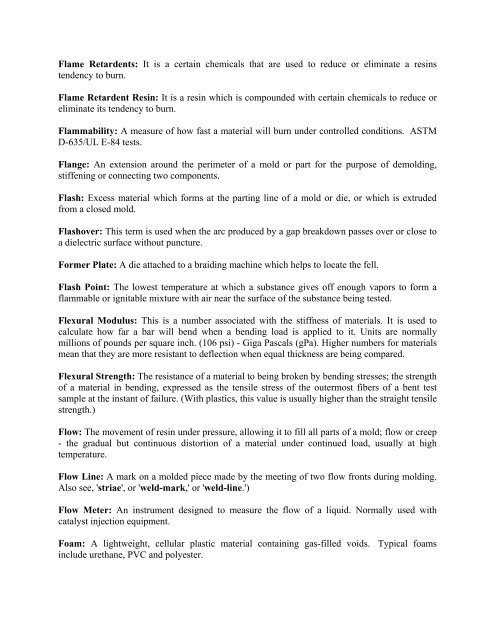Definitions /Dictionary/Glossary - nptel
Definitions /Dictionary/Glossary - nptel
Definitions /Dictionary/Glossary - nptel
You also want an ePaper? Increase the reach of your titles
YUMPU automatically turns print PDFs into web optimized ePapers that Google loves.
Flame Retardents: It is a certain chemicals that are used to reduce or eliminate a resins<br />
tendency to burn.<br />
Flame Retardent Resin: It is a resin which is compounded with certain chemicals to reduce or<br />
eliminate its tendency to burn.<br />
Flammability: A measure of how fast a material will burn under controlled conditions. ASTM<br />
D-635/UL E-84 tests.<br />
Flange: An extension around the perimeter of a mold or part for the purpose of demolding,<br />
stiffening or connecting two components.<br />
Flash: Excess material which forms at the parting line of a mold or die, or which is extruded<br />
from a closed mold.<br />
Flashover: This term is used when the arc produced by a gap breakdown passes over or close to<br />
a dielectric surface without puncture.<br />
Former Plate: A die attached to a braiding machine which helps to locate the fell.<br />
Flash Point: The lowest temperature at which a substance gives off enough vapors to form a<br />
flammable or ignitable mixture with air near the surface of the substance being tested.<br />
Flexural Modulus: This is a number associated with the stiffness of materials. It is used to<br />
calculate how far a bar will bend when a bending load is applied to it. Units are normally<br />
millions of pounds per square inch. (106 psi) - Giga Pascals (gPa). Higher numbers for materials<br />
mean that they are more resistant to deflection when equal thickness are being compared.<br />
Flexural Strength: The resistance of a material to being broken by bending stresses; the strength<br />
of a material in bending, expressed as the tensile stress of the outermost fibers of a bent test<br />
sample at the instant of failure. (With plastics, this value is usually higher than the straight tensile<br />
strength.)<br />
Flow: The movement of resin under pressure, allowing it to fill all parts of a mold; flow or creep<br />
- the gradual but continuous distortion of a material under continued load, usually at high<br />
temperature.<br />
Flow Line: A mark on a molded piece made by the meeting of two flow fronts during molding.<br />
Also see, 'striae', or 'weld-mark,' or 'weld-line.')<br />
Flow Meter: An instrument designed to measure the flow of a liquid. Normally used with<br />
catalyst injection equipment.<br />
Foam: A lightweight, cellular plastic material containing gas-filled voids. Typical foams<br />
include urethane, PVC and polyester.
















